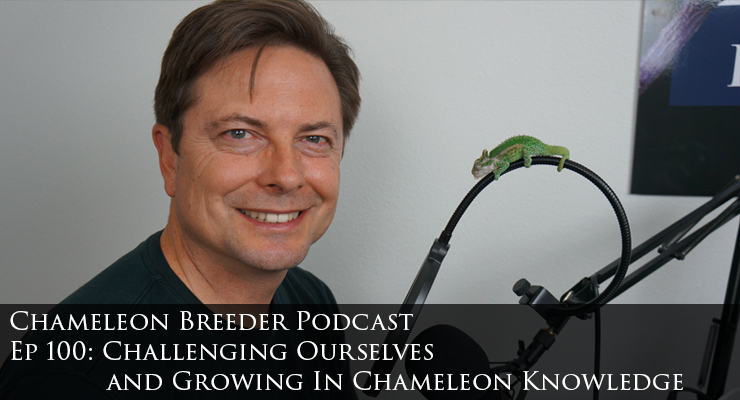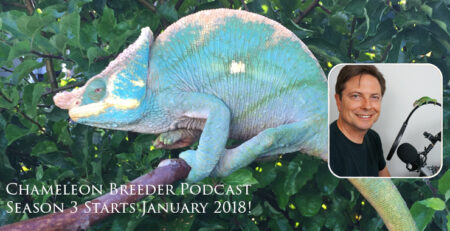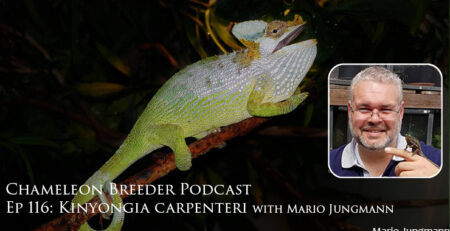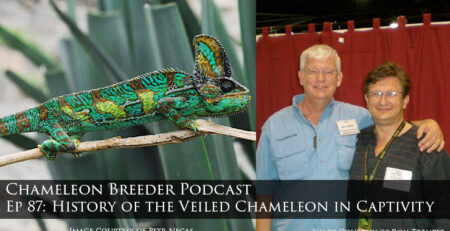Ep 100: Challenging Ourselves and Growing in Chameleon Knowledge

Welcome to Season Four and Episode 100!
It has been quite a ride so far and we have learned so much in the process. These last years have been an incredible growth period for me. And growth means you have to constantly challenge an re-evaluate what you think you know. If there are holes in the story you hold on to or leaps of logic that are trying too hard then a good challenge will flush those out!
Today I look back on the challenges that I have done for myself. I re-evaluate my stance on water and hydration being used to wash out chameleon eyes. I then talk about the challenges we have with Vitamin A and working with the influx of new keepers into the chameleon community. The community is shifting away from taking pride in research to demanding quick answers. How will we answer the challenge of simplifying a complex concept? Well, this all is why the next 100 episodes will be packed full!
I mentioned the email list. I am sending out a monthly email that will allow me to share things that are more topical and don’t make it on the podcast! Click here to go to the sign up page
Here are the transcripts -more or less – of Episode 100: Challenging Ourselves and Growing in Chameleon Knowledge
Welcome Chameleon Wranglers to the start of another season of the Chameleon Breeder Podcast! This is episode 100 so we have been through a lot together. If you have started at episode 1 you have gotten to know me, a lot of people in the chameleon community, and have gotten an in depth exposure to the incredible world of the chameleon. If this is your first episode, well, you’ve come to the place where we discuss the art and science of chameleon keeping. We explore, share, and go beyond just keeping a pet to learning about the world through our love for these modern day dragons. This is what the chameleon breeder podcast is all about and I, am your host Bill Strand.
One thing I have always said from the beginning is that this podcast was not meant to be me giving a lecture, but it is really me doing graduate studies and just taking you along with me! These episodes that I have put together are things I want to know and by hosting this show I am able to talk with the scientists and breeders that are exploring topics that take us forward. And if it is me talking you know there are hours and sometimes years of research experimenting behind what I am sharing. For example, many of you know I started the Dragon Strand Chameleon Caging company. I had been refining that Dragon Strand cage style combination of solid sides and screen panels for about 20 years before deciding to productize the design. Regardless of how long you have been doing something, our knowledge constantly moves forward. Keeping sharp and hungry is the only way to keep up. And so this is the perfect time to look around. If this is a vehicle for growth, has it done its job?
The answer is yes. The biggest change in my understanding has been in the area of hydration. One major switch is that I have backed off on presenting misting and showering as necessary for eye health. This is something we in the community believed and something I definitely pushed on this podcast. I would say that water is critical for hydration and hygiene. Now, I don’t know that that is wrong, but I am not as confident that it is right. I’ll go ahead and lay out the history. It is worthwhile to explore how thoughts in the community evolve. If you just take a snap shot of topics being discussed passionately on your favorite social media site you would think these people know beyond a shadow of a doubt what they are saying. Well, they certainly think they do! But let me tell you a story that is based on as true as a subjective view of history can be.
So in the “early part of this century” we struggled with eye issues. One hypothesis was that chameleons needed to clean their eyes out and with watching them roll their eye inside its turret during misting and showering this seemed reasonable. It seemed that things would be getting better the more we in the community talked about misting them more. How can you argue with success? And by “we” I mean my circle of chameleon people. I am from the Southern California English Speaking Mainstream Digital Communication Chapter of the Chameleon community. It says so right here on my ID card. By being on the forefront of the latest listserves, forums, social media, and content sharing platforms I tend to hang out in the largest groups. But I can never lose sight of how my perception has been molded by my early experience. Note that there are always groups of people that are not on the Yahoo listserve, Chameleon Journals Forum, Chameleonforums, Facebook, or speak an entirely different language. And everyone has their own group culture. Do you know there is a chameleon faction that believes that drinking water droplets off of leaves causes respiratory infections? So they teach their chameleons to drink out of cups of water. And there are groups that band around certain lighting or husbandry philosophies. Groups that form due to geography, language or philosophy. And the only thing that is common across them all is that they know they are right. So realize that we all are influenced by the group we are in – whether we even realize that we are in a group or not.
I bring that up to acknowledge that what I share with you comes from my personal experience and is, in no way, representative of everyone out there. But anyway, let’s get on with that story of mine.
So I was going on talking about how chameleons needed the mist to wash out their eyes. There was a published paper that suggested it so it isn’t a radical concept. But here is where the problem lies. Chameleons don’t like to be misted on. When the rain comes or mist turns on, they run away and hide from it. We all noticed the behavior of running away and explained it away that it was the shock of water suddenly hitting them. Which is fair and undoubtedly true! So I would advise to have a long misting session so the chameleon could settle down and finally do his drinking and eye washing. In fact, the misting session wasn’t considered effective until we saw drinking and eye washing. And this is how it went. Long misting sessions. Finally drinking. Finally eye washing. Success. See you tomorrow. No eye issues. Excellent, shall we solve world hunger next?
Well, it always bothered me that chameleons did not like being sprayed with water. Even a gentle spray. If it took minutes to get them to drink, how in the world did they survive in the wild when they went long months without a whole lot of rain? They better learn to drink dew and that isn’t going to rain on them for five minutes twice a day!
And then the cleaning of the eyes. If they truly needed that to maintain their most valuable sense of vision, then wouldn’t they be chomping at the bit waiting for the next rain shower so they could keep their sight in top working order? Without sight they die. Simple as that. In the trees there is no social structure that can help a chameleon that is blinded. They simply die. So eye health is critical. But, here they were avoiding critical maintenance.
So there were pieces not fitting well enough. Whenever pieces do not fit we need to have the courage to keep looking. It is very comfortable to just ignore the non-fitting parts and hold onto our belief. It is distressing to have loose ends. So much so, that us humans will actually ignore loose ends or contradicting information to keep our story safe! Well, keeping stories safe is not what we are doing here on this podcast. We are making sure our stories are solid and can stand any challenge! On this topic, I have to give credit to long discussions with Petr Necas who challenged the story I had put together. Of course, I am here to challenge everything I am saying so I welcomed that. I tore down everything and started to build it back up piece by piece without holding onto anything I thought before. And I found I could create another different story that worked as well.
So let’s paint a different picture. How about if we take the chameleon’s aversion to rain on face value. One thing we know is that chameleons can be induced to drink. Have you ever given your chameleon water using a pipette? You can give them water this way and if they are thirsty they will actively drink. But you can also use their instincts to get them to drink involuntarily. Now, it isn’t against their will as they can always run away, but sometimes they will just drink even if they are hydrated. So, there is a scenario that a chameleon hunkered down in the rain that they can’t get out of will resist drinking because he is not thirsty, but once they settle in and resign themselves to rain they may reflexively gulp the water that is gathering on their snout. Granted, a dehydrated chameleon will gulp water anywhere. But I am talking about a perfectly hydrated chameleon here. So maybe the gulping we are seeing is not thirst, but just instinct.
And the eye washing. Could that actually be irritation at water getting into their eyes and them trying to get it out? Could I be inadvertently annoying my chameleon when I thought I was giving them a healthy mist shower?
See, here is the problem we have putting together chameleon husbandry. I have put together two scenarios that fit the observations. And, to be clear, there are things I could challenge about the new scenario as well. Even after the rest period when they start their drinking they seem to search out the areas where water is to drink so it isn’t all just a reflexive action. So is it one, the other, a combination of them both with something I haven’t considered sprinkled in? This is where one group picks one side and another group pick the other and they argue forever because they are both as right as is possible with the information known. And since neither side can produce anything more than saying “I AM RIGHT” louder we may as well start a war, kill the infidels, and solve it that way. But seriously, there is so much that we think we know and it is, in reality, a straw house waiting to be blown over.
So, wait a minute, what about that decrease in eye problems? Well, how about we look at all the pieces. There are three general eye issues we run into in the chameleon community. Eye infections which are bacterial in nature, foreign debris that is irritating them, and vitamin A deficiency which produces a miserable looking swelling. I’ll leave out foreign debris for now because we knew what that looked like. What if the majority of the issues that we were defining the problem to be solved by were actually vitamin A deficiency and had nothing to do with bacteria in the eye. While it is true a vet could tell the difference, we were dealing with judgement of keepers of various experiences in deciding what the condition was. What if the decrease in eye issues was the switching over from Miner-al, which was very popular in the community and has no vitamin A, to Repashy Calcium Plus and Calcium Plus Lo-D which has vitamin A. Could it be that the problem decreasing was due to something else entirely that just coincidently was running in parallel to our whole hydration exploration? The thing is, this happens ALL THE TIME. We humans are pattern seekers. That is how we solve problems. With it we can build mega cities, put a man on the moon, and create history’s most effective method of delivering cute kitten videos to billions of people. But more than just pattern “seekers”, we are addicted to patterns and are uncomfortable unless we pull a pattern out of the chaos. Ever wonder why when someone decides their chameleon has a respiratory infection due to the color of the LED light on their fountain that they are highly defensive of their conclusion? It is because a conclusion is the end to the stress of not knowing and the last thing we want to do is reopen a closed case. Deep down we would rather stop with the comfort of having an answer than continue to push to make sure we have the right answer. This is human nature.
So where does this eye wash issue stand now? We just don’t know. I can take both scenarios and present them with enough confidence and support that there is no clear winner. Welcome to the gray area in chameleon husbandry. With just enough information to put together two equally good scenarios with the pieces it is hard to say. My bottom line is that we watch the behavior of the chameleons and let them guide us. In this case, the chameleons shy away from the spray and mist, even when it is gentle. So I am more comfortable embracing a hypothesis that includes that behavior. At this time this means that I am pulling back on pushing the idea that chameleons need showers for their eyes. I do not have conclusive proof one way or the other, but I have enough built up that I am going to stay silent on the subject. I continue to speak to scientists and will, of course, report back if I find something that adds light to this subject. In the meantime, I am updating episode 9 where I spoke on hydration. Most podcasts don’t update the back library, but most podcasts aren’t creating reference material that is constantly linked to. I am and so it is reasonable and worthwhile for me to update previous episodes. And when I do update episodes I will include a note to let the listener know that the information in that podcast has been updated.
So, how are you doing with ambiguity? I hate to tell you this, but much of chameleon husbandry is still mired in ambiguity. Want another one? Vitamin A. Some of us find that our chameleons develop vitamin A deficiency symptoms if we don’t supplement vitamin A. We find that supplementing vitamin A to the female before laying her eggs has a noticeable effect on the vigor of chameleon offspring. So what is the problem? The problem is that by giving preformed vitamin A orally in our supplement powder we enter into a dangerous space where we totally bypass the internal system that creates and regulates retinol, the useable form of vitamin A, and we can overdose with vitamin A. You see, most animals use carotenoids found in plant material to manufacture a useable form of vitamin A. The only other reliable place to get vitamin A is to eat vertebrate animals. The reason why we cannot accept the solution to be giving oral vitamin A is because we cannot determine where they would get the end form of vitamin A in the wild. According to what we know at this time, they have to be getting it from the insects they eat. Since the preformed vitamin A content of insects is very small, it would follow that the insects are providing the carotenoids – or whatever building blocks of vitamin A the chameleon‘s body is using. Although we cannot dispute that supplementing with the immediately useable vitamin A has demonstrated benefits, we also cannot yet put a finger on why some chameleons are raised and live a long healthy life without ever being given a vitamin A supplement. Are some chameleons living on the edge of vitamin deficiency all their life? Are chameleons converting carotenoids derived from the plant matter fed their feeder insects? Dr. Gary Ferguson did a study where Beta Carotene, a major carotenoid that many animals use as a provitamin to manufacture vitamin A, did not appear to be converted by panther chameleons. Perhaps chameleons use other carotenoids? Perhaps other carotenoids or some other vitamin in a certain balance is needed? Could some other part of the nutrition in his experiment negated the manufacture of vitamin A? The reason why we have so many questions surrounding vitamin A is that, as far as we know, giving oral vitamin A is not the natural process for chameleons. So we cannot just be satisfied with that option. Sure, we can include vitamin A in our supplementation. But we need to always be searching for the better answer that does not bypass the internal manufacturing and regulation that prevents vitamin A poisoning. And, yes, vitamin A is toxic in overdose. And there is no measure as to how much is too much. We are shooting in the dark here.
It is the same with vitamin D3, except that vitamin D3 has much more awareness in the community. I have actually done three episodes on vitamin D3! Like vitamin A, we know that giving vitamin D3 orally is not natural and bypasses the chameleon’s internal safety switch of regulating how much vitamin D3 is in the body. We know that we can give vitamin D3 orally and that it has been done safely for decades. Vitamin D3 overdose is definitely a problem, but we have dialed in our dosages to where it is safe to use certain levels of dietary vitamin D3. But, we, as dedicated hobbyists, cannot accept that. We need to keep pushing until we are able to raise up chameleons who get their vitamin D3 through the natural method of UVB to skin. It is the same with vitamin A. We are at a point where we see the benefits of giving more vitamin A orally to some of our chameleons. But we cannot accept this as an answer. It is only a middle step until we can put together the full picture of how chameleons get their vitamin A in the wild and we recreate that in our husbandry. So, unfortunately, any time you think you have a definitive answer in the chameleon world it is because you haven’t looked carefully enough! I guess the bright side is that I’ll have no problem putting together a 100 more episodes of this podcast trying to pick out the subtilties of the universe.
I bring up this example not to confuse an already complicated situation, but to demonstrate how dynamic our education must be. We must always be challenging what we think we know. So where do we go from here? We explore. We experiment. From that we learn, share, and discuss with others that are on the same path of exploration. I appreciate your indulgence of mypersonal development. I guarantee I will continue to challenge pretty much everything I think I know and will take you along with me. So, just to be clear, this podcast is not about wrapping things up in a bow and putting them under the Christmas tree. It is about tearing apart whatever we think we know and putting it back together better. So, I fear listening to me will never be totally comforting unless you are comforted by being on the frontier edge. The sunsets are beautiful out here –inspiring and thought provoking-makes you feel alive, but there are always bugs crawling around the sleeping bag. We can never totally relax and get rid of those nagging questions that keep us awake. Ah well, with a can of coffee warmed over a fire and someone strumming a guitar we can at least have a good time as we squeeze the world’s secrets out.
Now, one thing I have noticed while monitoring the Facebook chameleon groups is that there seems to be a greater influx of beginners that are learning about chameleons for the first time. This is as opposed to beginners who have done plenty of research before getting their chameleon. There is no surprise that these beginners have purchased from a pet store or from a reptile show and have come away with little as far as information. In order to get in front of this problem we need to understand the problem. So I went to a local PetSmart and a local reptile specialty store and asked what I would need to care for a chameleon. I was pleasantly surprised to find the answers I got hitting closer to the mark than not. I disagreed with both of their suggestions of using moist substrate to keep up the humidity. And, my goodness, please don’t tell people to leave heat lamps on all night to provide warmth! But overall most of the answers weren’t bad. The obvious issue was that even if the information was 100% good, there is no way someone could 1) remember it all or 2) execute it properly from the highlights they were told. And where could I get more information? I am sure you will be shocked to learn that pet stores warn people to be careful going to the internet because everyone has an opinion and it will just be confusing. So, the amorphous blob known as the internet generally tells everyone not to listen to pet store employees. The pet stores are telling customers to be very careful about the chaos on the internet. Any wonder why there is such confusion?
We are entering into a new chapter in our community. It used to be that you reached the community after working hard to find us. We weren’t hiding, but the mechanisms were not in place to make it easy to someone not working hard at it. Today, you search for chameleons on Facebook, or the social media of your choice, and you find a community. It is not only easy, but there is an expectation that it will be easy. We are getting people who can’t be bothered to check out a website. Literally, clicking a link in a Facebook post is becoming too much work. The fact that you are listening to a podcast to further your research means you have gone through more effort than some are willing to take.
One trend that concerns me personally is the expectation that there areeasy answers. And, of course, there is no shortage of people who would love to give easy answers. For example, ask what UVB does a veiled chameleon need? You’ll get many people who will give an answer: Arcadia 12% or ZooMed 10.0 T5 High Output. That’s the easy answer. But it is only easy if you don’t consider how big the cage is. Or where the bask branch is. Or whether there is such thing as too much UVB. How about for a baby. And if there is, can 12% be used incorrectly and cause problems? All these discussions are not able to be had when we simplify the answer to the absolute bare bones. Asking what they should do instead of asking why is it done that way is a common request. Although this gets them with a set up cage, the cage may not be set up correctly. I have resisted giving an easy answer in my dealings, but I cannot deny that it gets the person further than they were before. So it is now time to create picture books. It is a dangerous thing to simplify things so much, but we are at a time where it looks like we will have to supplement with preformed answers that bypass the brain’s analysis and hope we don’t overdose and get laziness poisoning. Speed seems to be of the essence. I was discussing this with someone who was pointing out that I didn’t give easily digested answers. I said there was no easy answer and it being difficult was no excuse for ignoring the real answer. The person digitally shrugged and informed me that that was not what the people wanted to hear. Um, okay…that’s it? So, once again, time to evolve – or fade away to your cave. It will be interesting to see if we in the community can find the balance between simple and effective. Time to get creative. Check back with me at episode 200 and I’ll let you know how it went.
As for this podcast, here it is all about the “why” and the messy bits. It is time to start season four. Those of you who are on the email list have already seen what episodes are coming up. If you are enjoying the podcast and would like to learn more about what is going on then go to chameleonbreeder.com and join up on the email list.And with that, I am going to sign off and get ready to hit the trail hard. Next week we are going to catch up with Mark Scherz as he treks to a remote part of Madagascar to study the difference a little elevation makes in the species there. If all goes well, that study will earn him his doctorate, The trip started off as idyllic as we dream the life of a field scientist to be, but the universe did not want to let him off easy. Join us next week as we dive into a real scientific expedition with all the ups and downs included.
This is Bill Strand signing off. Go into that world and soak up everything it has to offer. Learn, Understand, and pass it on. This is our community..Take care of each other and keep us strong. I’ll see you next time, on the Chameleon Breeder Podcast.











